Eczematous Disorders
Nicole R. Bender, Yvonne E. Chiu
Skin disorders are a broad group of cutaneous eruptions characterized by erythema, edema, and pruritus. Acute eczematous lesions demonstrate erythema, weeping, oozing, and the formation of microvesicles within the epidermis. Chronic lesions are generally thickened, dry, and scaly, with coarse skin markings (lichenification) and altered pigmentation. Many types of eczema occur in children; the most common is atopic dermatitis (see Chapter 170 ), although seborrheic dermatitis, allergic and irritant contact dermatitis, nummular eczema, and acute palmoplantar eczema (dyshidrosis) are also relatively common in childhood.
Once the diagnosis of eczema has been established, it is important to further classify the eruption more specifically for proper management. Pertinent historical data often provide the clue. In some instances, the subsequent course and character of the eruption permit classification. Histologic changes are relatively nonspecific, but all types of eczematous dermatitis are characterized by intraepidermal edema known as spongiosis.
Contact Dermatitis
Nicole R. Bender, Yvonne E. Chiu
The form of eczema known as contact dermatitis can be subdivided into irritant dermatitis, in which nonspecific injury to the skin causes immediate inflammation, and allergic contact dermatitis, resulting from a delayed hypersensitivity reaction. Irritant dermatitis is more frequent in children, particularly during the early years of life. Allergic reactions increase in frequency upon maturation of the immune system.
Irritant Contact Dermatitis
Irritant contact dermatitis can result from prolonged or repetitive contact with physical, chemical, or mechanical irritants, including saliva, urine, feces, fragrance, detergents, dyes, henna, plants, caterpillars, abrasive materials, and chafing.
Irritant contact dermatitis may be difficult to distinguish from atopic dermatitis or allergic contact dermatitis. A detailed history and consideration of the sites of involvement, the age of the child, and contactants usually provide clues to the etiologic agent. The propensity for development of irritant dermatitis varies considerably among children; some may respond to minimal injury, making it difficult to identify the offending agent through history. Children with atopic dermatitis are more prone to irritant contact dermatitis as an exacerbating factor. Irritant contact dermatitis usually clears after removal of the stimulus and temporary treatment with a topical corticosteroid preparation (see Chapter 665 ). Education of patients and parents about the causes of contact dermatitis is crucial to successful therapy.
Dry skin dermatitis results from repetitive wet-to-dry behaviors such as lip licking (Fig. 674.1 ), thumb sucking, frequent handwashing, or excessive sweating. Involved skin is erythematous and fissured, localized to the area of exposure. Treatment of dry skin dermatitis begins with eliminating the offending wet-to-dry behavior. Moisturizer cream applied twice daily decreases transepidermal water loss and replenishes skin lipids to improve hydration. A topical steroid is usually necessary to treat the inflammation.
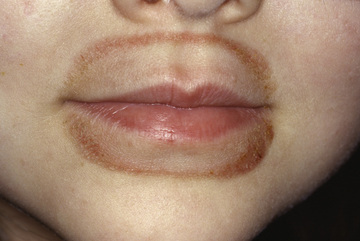
Juvenile plantar dermatosis occurs mainly in prepubertal children with hyperhidrosis who wear occlusive synthetic footwear. Weight-bearing surfaces of the foot may be pruritic or painful and develop a fissured or glazed appearance (Fig. 674.2 ). Immediate application of a thick emollient when socks and shoes are removed or immediately after swimming usually minimizes juvenile plantar dermatosis. Severe inflammatory cases may require short-term (1-2 wk) application of a medium- to high-potency topical steroid.
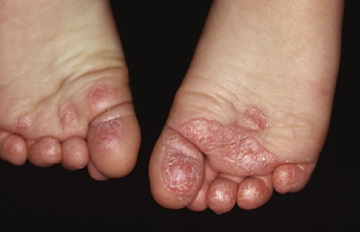
Diaper Dermatitis
Diaper dermatitis refers to any rash in the diaper region; the most common of these is irritant diaper dermatitis. Elevated pH in the diaper area and synergistic activity of urinary and fecal enzymes lead to inflammation, which disrupts the normal skin barrier and increases susceptibility to other irritants and organisms. Additional factors are occlusion, friction, and use of diaper wipes and topical preparations. Loose or frequent stooling predisposes an infant to diaper dermatitis. Diaper dermatitis presents with erythema and scaling, often with papulovesicular or bullous lesions, fissures, and erosions in a patchy or confluent pattern (Fig. 674.3 ). The genitocrural folds are often spared because concave areas are relatively protected. Chronic hypertrophic, flat-topped papules and infiltrative nodules may occur. Candidal infection typically represents a secondary process. It is characterized by “beefy” red-pink, tender skin that has numerous 1-2 mm pustules and satellite papules and involves both concave and convex areas. Discomfort may be marked because of intense inflammation. Allergic contact dermatitis, seborrheic dermatitis, psoriasis, candidiasis, atopic dermatitis, child abuse, and rare disorders such as Langerhans cell histiocytosis, nutritional deficiencies, and acrodermatitis enteropathica should be considered when the eruption is persistent or is recalcitrant to simple therapeutic measures.
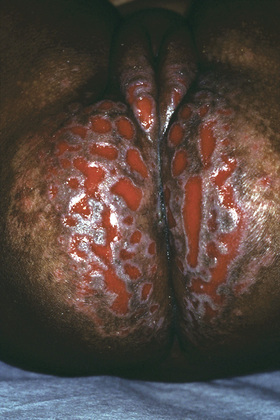
Diaper dermatitis often responds to simple measures; some infants are predisposed to diaper dermatitis, and management may be difficult. The damaging effects of overhydration of the skin and prolonged contact with feces and urine can be obviated by frequent changing of the diapers and periods of “rest” free of diaper use. Cleansing of affected skin is best accomplished with a soft cloth and lukewarm water, patted dry. Overwashing should be avoided because it leads to chapping and may worsen the dermatitis. Disposable diapers containing a superabsorbent material may help to maintain a relatively dry environment. First-line therapy for diaper dermatitis is application of a protective barrier agent (ointment or paste) containing petroleum or zinc oxide at every diaper change. Topical sucralfate is an effective barrier with some antibacterial activity, useful for recalcitrant cases. Low-potency nonhalogenated topical corticosteroids, such as 2.5% hydrocortisone, may be used for short time periods (3-5 days). Treatment with a topical anticandidal agent is indicated for secondary candidal infection. Topical preparations containing triamcinolone-nystatin and betamethasone dipropionate-clotrimazole are generally inappropriate for diaper dermatitis in infants because of the higher potency of the corticosteroid component. If using multiple topical agents, the protective barrier should be applied last. When diaper dermatitis does not respond to typical prevention and treatment strategies, non–diaper-associated causes must be considered.
Allergic Contact Dermatitis
Allergic contact dermatitis is common in childhood and should be considered in any child with recalcitrant eczema. Allergic contact dermatitis is underestimated in children with atopic dermatitis, and it has been reported to affect up to 41–77% of all children in the United States. This is a T-cell–mediated hypersensitivity reaction that is provoked by application of an antigen to the skin surface. The antigen penetrates the skin, where it is conjugated with a cutaneous protein, and the hapten-protein complex is transported to the regional lymph nodes by antigen-presenting Langerhans cells. A primary immunologic response occurs locally in the nodes and becomes generalized, presumably because of dissemination of sensitized T cells. Sensitization requires several days and, when followed by a fresh antigenic challenge, manifests as allergic contact dermatitis. Generalized distribution may also occur if enough antigen finds its way into the circulation, such as by consumption. Once sensitization has occurred, each new antigenic challenge may provoke an inflammatory reaction within 8-12 hr; sensitization to a particular antigen usually persists for many years.
Acute allergic contact dermatitis is an erythematous, intensely pruritic, eczematous dermatitis. Acute cases may be edematous and vesiculobullous. The chronic condition has the features of long-standing eczema: lichenification, scaling, fissuring, and pigmentary change. Distinguishing allergic contact dermatitis from other eczematous disorders can be challenging, especially with irritant contact dermatitis which can be clinically identical. The distribution of the eruption often provides a clue to the diagnosis. Airborne sensitizers usually affect exposed areas, such as the face and arms. Jewelry, topical agents, shoes, clothing, henna tattoo dyes, plants, and even toilet seats cause dermatitis at points of contact. Careful evaluation of environmental exposures, cultural customs, daily activity, animal exposures, ear piercing, tattooing, and personal product usage in the patient and all caregivers is essential. Other potential diagnoses to consider include herpes simplex virus, impetigo, cellulitis, and dermatophytoses.
Rhus dermatitis (poison ivy, poison sumac, poison oak), a response to the plant allergen urushiol, is the most common allergic contact dermatitis. It is often vesiculobullous and may be distinguished by linear streaks of vesicles where the plant leaves have brushed against the skin (Fig. 674.4 ). Fluid from ruptured cutaneous vesicles does not spread the eruption; antigen retained on skin, clothing, or under fingernails initiates new plaques of dermatitis if not removed by washing with soap and water. Antigen may also be carried by animals on their fur. “Black spot” poison ivy dermatitis is a rare variant that results from oxidation of concentrated urushiol left on the skin and manifests as small discrete black lacquer–like glossy papules with surrounding erythema and edema. Sensitization to one plant produces cross reactions with the others. Spontaneous resolution occurs in 1-3 wk, with the most common complication being secondary bacterial infection with normal skin flora. Exposure avoidance and thorough washing after exposure are the mainstays for prevention. Barrier creams or organoclay compounds such as bentoquatam may be effective if applied prior to expected exposure.
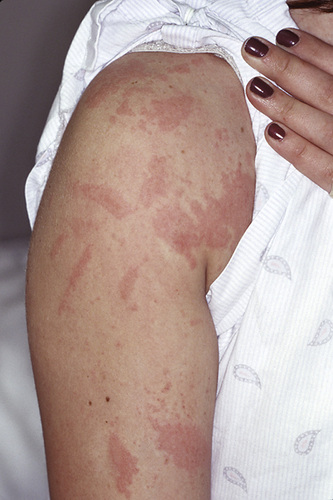
Nickel dermatitis develops from contact with jewelry, metal closures on clothing, or even cell phones. Metal closures on pants frequently cause periumbilical dermatitis (Fig. 674.5 ). Some children are exquisitely sensitive to nickel, with even the trace amounts found in gold jewelry provoking eruptions. The most frequently involved sites from jewelry are the earlobes from nickel-containing earrings. Early ear piercing increases risk of sensitization, and it is recommended to delay piercing until after 10 yr of age. Patch testing for nickel sensitivity is unreliable in infants and toddlers and should only be performed if there is high clinical suspicion.
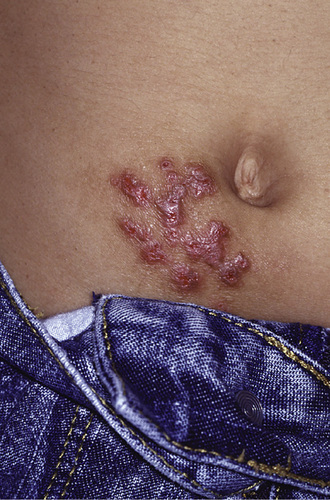
Shoe dermatitis typically affects the dorsum or soles of the feet and toes, sparing the interdigital spaces; it is usually symmetric. Other forms of allergic contact dermatitis, in contrast to irritant dermatitis, rarely involve the palms and soles. Common allergens are the antioxidants and accelerators in shoe rubber, adhesives, and the chromium salts in tanned leather or shoe dyes. Excessive sweating often leaches these substances from their source.
Apparel contains a number of sensitizers, including dyes, dye fixative, fabric finishes, fibers, resins, and cleaning solutions. Dye may be poorly fixed to clothing and so may be leached out with sweating, as can partially cured formaldehyde resins. The elastic in garments is a frequent cause of clothing dermatitis, and contact allergy to the ink “tag” of tagless baby clothing has been reported. Exposure to other items with fabric, such as infant car seats, may induce reactions similar to clothing.
Topical medications and cosmetics may be unsuspected as allergens, particularly if a medication is being used for a preexisting dermatitis. The most common offenders are neomycin, topical antihistamines, topical anesthetics, fragrances, topical corticosteroids, oxybenzone, and octocrylene in chemical sunscreens, preservatives, dye in temporary tattoos, and ethylenediamine, a stabilizer present in many medications. All types of cosmetics can cause facial dermatitis; involvement of the eyelids is characteristic for nail polish sensitivity.
Neomycin sulfate is present in many nonprescription topical antibiotic preparations, and thus children are frequently exposed at an early age. It is one of the most common causes of allergic contact dermatitis, and use of combination products of neomycin with other antibiotics, antifungals, or corticosteroids may induce co-reactivity with these chemically unrelated substances.
As mentioned previously, diagnosis of allergic contact dermatitis is usually based on history; however, patch testing may be helpful, especially in older children. Identification and avoidance of the offending agent is the mainstay of managing allergic contact dermatitis. First-line treatment for acute eruption is mid-potency topical corticosteroid ointment for 2-3 wk, as well as symptom management with nonsensitizing and fragrance-free emollients/moisturizers, wet dressings, and sedating antihistamines to allow for sleep. Systemic corticosteroids are used when >10% of skin is involved (0.5-1.0 mg/kg prednisone for 7-10 days, followed by a 7-10 day taper). More chronic allergic contact dermatitis is treated with low- to mid-potency topical corticosteroids. Desensitization therapy is rarely indicated. Topical calcineurin inhibitors, such as tacrolimus, may be a potential steroid-sparing alternative agent in select patients.1
Bibliography
Fonacier LS, Aquino MR, Mucci T. Current strategies in treating severe contact dermatitis in pediatric patients. Curr Allergy Asthma Rep . 2012;12(6):599–606.
Goldenberg A, Admani S, Pelletier JL, Jacob SE. Belt buckles—increasing awareness of nickel exposure in children: a case report. Pediatrics . 2015;136(3):e691–e693.
Goldenberg A, Silverberg N, Silverberg JI, et al. Pediatric Allergic Contact Dermatitis: Lessons for Better Care. J Allergy Clin Immunol Pract. 2015;3(5):661–667.
Shin HT. Diagnosis and management of diaper dermatitis. Pediatr Clin North Am . 2014;61:367–382.
Tollefson MM, Bruckner AL. Atopic dermatitis: skin-directed management. Pediatrics . 2014;134(6):e1735–e1744.
Nummular Eczema
Nicole R. Bender, Yvonne E. Chiu
Nummular eczema is characterized by coin-shaped, severely pruritic, eczematous plaques, commonly involving the extensor surfaces of the extremities (Fig. 674.6 ), buttocks, and shoulders with facial sparing. The plaques are relatively discrete, boggy, vesicular, slightly scaly, and exudative; when chronic, they often become thickened and lichenified and may develop central clearing. The etiology remains unclear, although nummular eczema possibly represents an atypical morphology of atopic dermatitis. Flares are generally sporadic but may be precipitated by xerosis, irritants, allergens, or occult staphylococcal infection. Most frequently, these lesions are mistaken for tinea corporis, but plaques of nummular eczema are distinguished by the lack of a raised, sharply circumscribed border, the lack of fungal organisms on a potassium hydroxide (KOH) preparation, and frequent weeping or bleeding when scraped. First-line treatment is with emollients, wet dressings, and potent topical corticosteroids. Steroid-impregnated tapes may simultaneously treat and provide barrier protection to these circumscribed eczematous plaques. An oral antihistamine may be helpful, particularly a sedating antihistamine at night. Antibiotics are indicated for secondary infection.
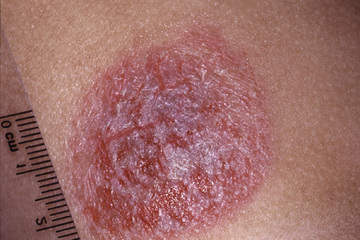
Pityriasis Alba
Nicole R. Bender, Yvonne E. Chiu
Pityriasis alba occurs mainly in children and causes lesions that are hypopigmented, ill-defined, round or oval patches (Fig. 674.7 ). They may be mildly erythematous and finely scaly. Lesions occur on the face, neck, upper trunk, and proximal portions of the arms and are most pronounced on darker skin tones or after tanning of surrounding skin. Itching is minimal or absent. The cause is unknown, but the eruption appears to be exacerbated by dryness and is often regarded as a mild form of atopic dermatitis. Pityriasis alba is frequently misdiagnosed as vitiligo, tinea versicolor, or tinea corporis. The lesions wax and wane but eventually disappear, and normal pigmentation often takes months to return. Application of a lubricant or emollient may ameliorate the condition, and avoidance of sun exposure and daily sunscreen use can help reduce the appearance of existing lesions by allowing for natural lightening of adjacent unaffected skin. If pruritus is troublesome, or if the lesions are active with erythema and fine scale, a low-potency topical steroid or calcineurin inhibitor may be used.
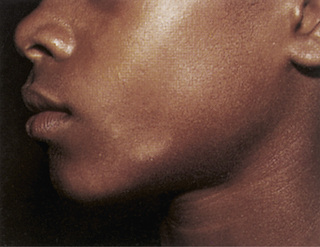
Lichen Simplex Chronicus
Nicole R. Bender, Yvonne E. Chiu
Lichen simplex chronicus is a secondary skin disorder resulting from excessive scratching or rubbing. It is characterized by a chronic pruritic, eczematous, circumscribed plaque that is usually lichenified and hyperpigmented (Fig. 674.8 ). All affected areas must be accessible to scratching, with the most common sites being the posterior neck, genitalia, wrists, ankles, and dorsal feet. Although the initiating event may be a transient lesion such as an insect bite, trauma from rubbing and scratching accounts for persistence of the plaque. Lichen simplex chronicus may also be seen in other chronic eczematous dermatoses such as atopic dermatitis, typically when poorly controlled. Pruritus must be controlled to permit healing, thus a covering to prevent scratching may be necessary. A high-potency topical corticosteroid under occlusion is often helpful and hastens resolution. Second-line therapy includes adding 6% salicylic acid gel to the topical corticosteroid preparation.
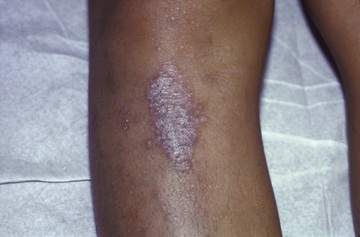
Acute Palmoplantar Eczema (Dyshidrotic Eczema, Dyshidrosis, Pompholyx)
Nicole R. Bender, Yvonne E. Chiu
A recurrent, sometimes seasonal, blistering disorder of the hands and feet, acute palmoplantar eczema occurs in all age groups but is uncommon in infancy. The pathogenesis is unknown, although possible predisposing factors include a history of atopy, exposure to contact allergens (especially metals) or irritants, or IV immunoglobulin therapy. The disease is characterized by recurrent crops of small, deep-seated “tapioca-like” vesicles, which are intensely pruritic and may coalesce into tense bullae (Fig. 674.9 ). Sites of predilection are the palms, soles, and lateral aspects of the fingers and toes. Primary lesions are noninflammatory and are filled with clear fluid, which, unlike sweat, has a physiologic pH and contains protein. Maceration and secondary infection are frequent because of scratching. The chronic phase is characterized by thickened, fissured plaques that may cause considerable discomfort, as well as dystrophic nails. Although acute palmoplantar eczema is frequently seen in patients with hyperhidrosis, histologic examination reveals an eczematous reaction around sweat ducts, without any structural or functional abnormalities of the sweat ducts themselves. The diagnosis is made clinically. The disorder may be confused with allergic contact dermatitis, which usually affects the dorsal rather than the volar surfaces, and with dermatophytosis, which can be distinguished by a KOH preparation of the roof of a vesicle and by appropriate cultures.
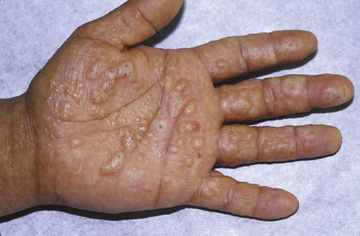
Acute palmoplantar eczema responds to wet dressings, liberal emollient use, and potent topical corticosteroid ointment applied twice daily for 2-4 wk. Weeping skin benefits from twice daily soaking in an astringent solution, such as aluminum subacetate. Second-line treatment is topical tacrolimus 0.1% ointment. Severe disease may require oral corticosteroids with 2 wk taper, or even phototherapy such as psoralen UVA and high-dose UVA1. Control of the chronic stage is difficult; lubricants containing mild keratolytic agents in conjunction with a potent topical fluorinated corticosteroid preparation may be indicated. Secondary bacterial infection should be treated systemically with an appropriate antibiotic. Patients should be told to expect recurrence and should protect their hands and feet from the damaging effects of excessive sweating, chemicals, harsh soaps, and adverse weather. Unfortunately, it is impossible to prevent recurrence or to predict its frequency.
Seborrheic Dermatitis
Nicole R. Bender, Yvonne E. Chiu
Etiology
Seborrheic dermatitis is a chronic inflammatory disease most common in infancy and adolescence that parallels the distribution, size, and activity of the sebaceous glands. The cause is unknown, as is the role of the sebaceous glands in the disease. Malassezia furfur is implicated as a causative agent, although it remains unclear whether dermatitis results from the action of the fungus, its byproducts, or an exaggerated response of the host. In adolescence, seborrheic dermatitis typically occurs after puberty, indicating a possible role for sex hormones.
It is also unknown whether infantile seborrheic dermatitis and adolescent seborrheic dermatitis are the same or different entities. There is no evidence that children with infantile seborrheic dermatitis will experience seborrheic dermatitis as adolescents.
Clinical Manifestations
The disorder may begin in the 1st month of life and typically self-resolves by 1 yr. Diffuse or focal scaling and crusting of the scalp, sometimes called cradle cap (Fig. 674.10 ), may be the initial and, at times, the only manifestation. A greasy, scaly, erythematous papular dermatitis, which is usually nonpruritic in infants, may involve the face, neck, retroauricular areas, axillae, umbilicus, and diaper area. The dermatitis may be patchy and focal or may spread to involve almost the entire body (Fig. 674.11 ). Postinflammatory pigmentary changes are common, particularly in black infants. When the scaling becomes pronounced, the condition may resemble psoriasis and, at times, can be distinguished only with difficulty. The possibility of coexistent atopic dermatitis must be considered when there is an acute weeping dermatitis with pruritus, and the two are often clinically inseparable at an early age. An intractable seborrhea-like dermatitis with chronic diarrhea and failure to thrive may reflect systemic dysfunction of the immune system. A chronic seborrhea-like pattern, which responds poorly to treatment, may also result from cutaneous histiocytic infiltrates in infants with Langerhans cell histiocytosis. Seborrheic dermatitis is a common cutaneous manifestation of AIDS in young adults and is characterized by thick, greasy scales on the scalp and large hyperkeratotic erythematous plaques on the face, chest, and genitals.
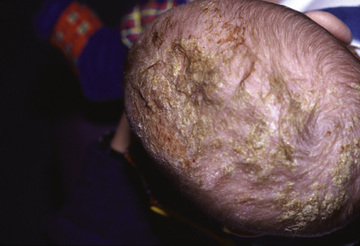
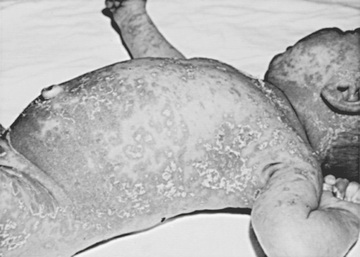
During adolescence, seborrheic dermatitis is more localized and may be confined to the scalp and intertriginous areas. Also noted may be marginal blepharitis and involvement of the external auditory canal. Scalp changes vary from diffuse, brawny scaling to focal areas of thick, oily, yellow crusts with underlying erythema. Loss of hair is common, and pruritus may be absent to marked. When the dermatitis is severe, erythema and scaling occur at the frontal hairline, the medial aspects of the eyebrows, and in the nasolabial and retroauricular folds. Red, scaly plaques may appear in the axillae, inguinal region, gluteal cleft, and umbilicus. On the extremities, seborrheic plaques may be more eczematous and less erythematous and demarcated. Unlike infantile seborrheic dermatitis, adolescent seborrheic dermatitis generally does not self-resolve and has a chronic relapsing course.
Differential Diagnosis
The differential diagnosis of seborrheic dermatitis includes psoriasis, atopic dermatitis, dermatophytosis, Langerhans cell histiocytosis, and candidiasis. Secondary bacterial infections and superimposed candidiasis are common.
Treatment
Initial management for infantile seborrheic dermatitis is generally conservative given the self-limited nature of this condition. Emollients, baby oil, gentle shampooing with nonmedicated baby shampoo, and gentle use of a soft brush to remove scales are usually effective measures. Persistent lesions may be treated with low-potency topical corticosteroids if inflamed (applied once daily for 1 wk) and a topical antifungal (e.g., ketoconazole 2% cream twice daily). Antifungal shampoos such as ketoconazole 2% shampoo should be used cautiously because they are not tear-free.
First-line therapy for children and adolescents with scalp seborrheic dermatitis is antifungal shampoo used several times weekly to daily (selenium sulfide, ketoconazole, ciclopirox, zinc pyrithione, salicylic acid, or tar). Mid-potency topical corticosteroids such as fluocinolone 0.01% shampoo may also be used for inflamed lesions, applied once daily for 2-4 wk. Nonscalp lesions are treated with topical corticosteroid cream (low-potency for facial lesions, mid-potency elsewhere), as well as topical antifungals such as ketoconazole 2% cream or ketoconazole 2% shampoo used as a body or face wash. Second-line therapy for seborrheic dermatitis includes topical calcineurin inhibitors and keratolytic agents such as urea. Severe adult cases improve with oral antifungal agents; however, pediatric studies are lacking. Once acute disease is controlled, antifungal shampoo used on a weekly basis is effective maintenance to reduce risk of relapse.